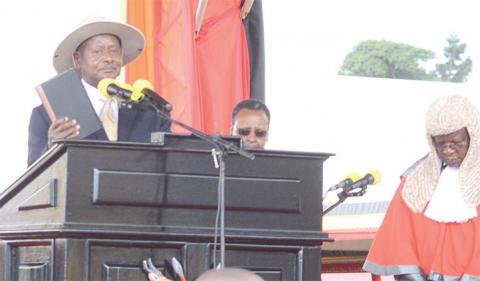Term, Age Limit: Activists Plot Court Action
Submitted by Christopher Tusiime on

In a yet-to-be-filed petition, the intending petitioners want the Constitutional court to declare that the removal of presidential term limits in 2005 affected the basic structure of the constitution.
The petition would also advocate the restoration of term limits, whose removal, the petitioners claim, caused Uganda’s current governance problems. The petition, according to sources familiar with the planning, would also seek to shield the constitutional age limit from being opened by proponents of President Museveni’s stay in power beyond 2021 after he clocks the 75-year age limit.
“We think that the current turbulent politics and other governance issues have been due to the abuse that was occasioned by Parliament in 2005, when the presidential term limits were scrapped from the constitution,” the source said in an interview.

So far, meetings have been convened to select individuals who will coordinate the petition, which to some in civil society is the most gigantic exercise that will occupy political debate as the political roadmap to 2021 takes shape.
Tentatively, human rights activist Jacqueline Asiimwe-Mwesige and lawyer Karoli Ssemogerere will coordinate the work plan. They will be assisted by Nicholas Opiyo of the human rights NGO Chapter Four Uganda, Prof Joe Oloka-Onyango, Dr Christopher Mbazira and Dr Busingye Kabumba, among others.
In an interview with The Observer on Friday, Asiimwe confirmed the petition was underway.
“We convened the meeting of the constitutional law brains and they said this is something that has not been done. I can say plans are underway,” Asiimwe said.
BASIC STRUCTURE
The good governance advocates are constructing their case on the argument that removal of term limits abrogated the basic structure upon which the constitution was built. According to Dr Busingye, a constitutional law lecturer at Makerere University and a sponsor of the petition, any constitution’s soul is reflected in its basic structure.
“So, it has been found in many jurisdictions in the world that any abrogation of the basic structure amounts to violation of the constitution,” Kabumba said.
The basic structure principle, which finds its expression in most of the constitutional law cases reported from India and South Africa, was developed by the supreme court of India in the case of Kesavananda Bharati v. The State of Kerala.
The court held that certain features of the Indian Constitution were beyond the limit of the powers of amendment of the Indian parliament. The principle, which has been applied variously by many others outside India, has been applied in judicial analysis by courts to determine whether particular constitutional amendments conform to the structure of a respective constitution under consideration.
In a book titled, Comparative Constitutionalism and Good Governance in the Commonwealth, the authors argue that due to the constitution’s vulnerability to retrogressive amendment, the principle enables judicial involvement in tackling ‘political’ questions and protecting fundamental constitutional provisions.
“Here a majority of the Indian Supreme court held that the basic institutional structure of the state must remain intact and thus Parliament could not amend the Constitution’s essential or basic structure, even through a formal constitutional amendment process, because this would amount not just to its amendment but to its replacement by a new document,” reads the book.
The authors further assert that although there is always an established process through which an appropriate amendment procedure of a constitution is achieved, its outcome becomes academic and leads to the denigration of constitutionalism.
As regards amendment of the constitution to remove presidential term limits, the authors argue against it on the basis that it affects the efficiency of state institutions.
In 2005, Parliament amended the Uganda Constitution by removing presidential term limits. Whereas under the 1995 Constitution, it had been envisaged by the framers that ideally, a president should serve only two-terms of five years each, in 2005, the seventh Parliament reasoned that this provision ran counter to people’s aspirations and it interfered with the people’s sovereignty to choose a leader they want.
But Asiimwe argues: “At the time the constitution was promulgated, it had been envisaged that the term limits would act as the general checks and balance on the excessive presidential powers in the constitution. It was assumed that if someone served for two terms, however much their excesses could be, they could be dealt with by their successor,” she said.
Asiimwe explained that since appointment of most important public servants is done by the president, when a president is made to rule for life, it means that those who work under him/her serve according to his/her whims.
“Institutions are beholden to one individual. The individual takes over every institution in pursuance of power consolidation scheme,” she said.
The petitioners, however, might have an uphill task swaying Ugandan courts, which have consistently shied away from political questions.
The writer is political journalist currently working with The Observer newspaper
- Log in to post comments
- 744 reads
